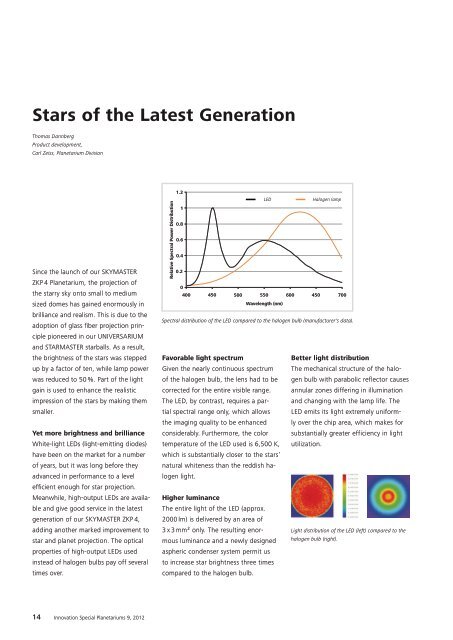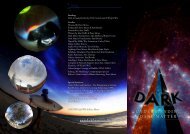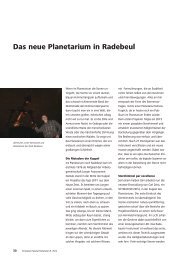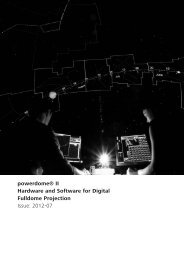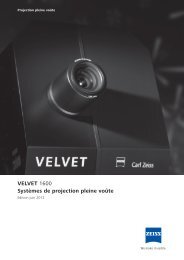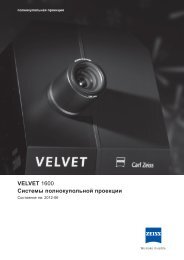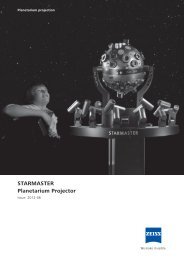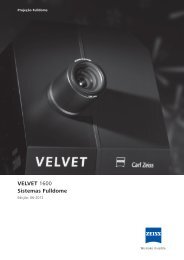Innovation Special Planetariums 9 - Carl Zeiss Planetariums
Innovation Special Planetariums 9 - Carl Zeiss Planetariums
Innovation Special Planetariums 9 - Carl Zeiss Planetariums
Create successful ePaper yourself
Turn your PDF publications into a flip-book with our unique Google optimized e-Paper software.
Stars of the Latest Generation<br />
Thomas Dannberg<br />
Product development,<br />
<strong>Carl</strong> <strong>Zeiss</strong>, Planetarium Division<br />
Since the launch of our SKYMASTER<br />
ZKP 4 Planetarium, the projection of<br />
the starry sky onto small to medium<br />
sized domes has gained enormously in<br />
brilliance and realism. This is due to the<br />
adoption of glass fiber projection principle<br />
pioneered in our UNIVERSARIUM<br />
and STARMASTER starballs. As a result,<br />
the brightness of the stars was stepped<br />
up by a factor of ten, while lamp power<br />
was reduced to 50 %. Part of the light<br />
gain is used to enhance the realistic<br />
impression of the stars by making them<br />
smaller.<br />
Yet more brightness and brilliance<br />
White-light LEDs (light-emitting diodes)<br />
have been on the market for a number<br />
of years, but it was long before they<br />
advanced in performance to a level<br />
efficient enough for star projection.<br />
Meanwhile, high-output LEDs are available<br />
and give good service in the latest<br />
generation of our SKYMASTER ZKP 4,<br />
adding another marked improvement to<br />
star and planet projection. The optical<br />
properties of high-output LEDs used<br />
instead of halogen bulbs pay off several<br />
times over.<br />
14 <strong>Innovation</strong> <strong>Special</strong> <strong>Planetariums</strong> 9, 2012<br />
Relative Spectral Power Distribution<br />
1.2<br />
1<br />
0.8<br />
0.6<br />
0.4<br />
0.2<br />
0<br />
400 450 500 550<br />
Wavelength (nm)<br />
600 450 700<br />
Spectral distribution of the LED compared to the halogen bulb (manufacturer's data).<br />
Favorable light spectrum<br />
Given the nearly continuous spectrum<br />
of the halogen bulb, the lens had to be<br />
corrected for the entire visible range.<br />
The LED, by contrast, requires a partial<br />
spectral range only, which allows<br />
the imaging quality to be enhanced<br />
con siderably. Furthermore, the color<br />
temperature of the LED used is 6,500 K,<br />
which is substantially closer to the stars’<br />
natural whiteness than the reddish halogen<br />
light.<br />
Higher luminance<br />
The entire light of the LED (approx.<br />
2000 lm) is delivered by an area of<br />
3 x 3 mm² only. The resulting enormous<br />
luminance and a newly designed<br />
aspheric condenser system permit us<br />
to increase star brightness three times<br />
compared to the halogen bulb.<br />
LED Halogen lamp<br />
Better light distribution<br />
The mechanical structure of the halogen<br />
bulb with parabolic reflector causes<br />
annular zones differing in illumination<br />
and changing with the lamp life. The<br />
LED emits its light extremely uniformly<br />
over the chip area, which makes for<br />
substantially greater efficiency in light<br />
utilization.<br />
Light distribution of the LED (left) compared to the<br />
halogen bulb (right).


